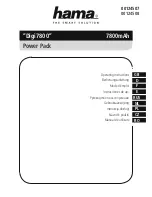
8
USE
• On/off switch with 2 air fl ow settings
3
! check if switch A
2
is in position “0” before
plugging in
- switch on the tool by pushing switch A in desired
position:
1 = air fl ow 250 litres/minute (50°C ... 550°C)
2 = air fl ow 500 litres/minute (50°C ... 650°C)
- when using it for the fi rst time, some smoke may emit
from the tool; this is normal and will soon cease
- switch off the tool by pushing switch A in position “0”
• Temperature setting
4
- set desired target temperature in steps of 10°C by
pressing buttons B briefl y
- pressing buttons B constantly increases/decreases
the target temperature continuously until the buttons
are released or the minimum/maximum temperature
is reached
- after the target temperature is set, display C shows
the actual rising/falling temperature until the desired
temperature is reached
- the target temperature applies for both air fl ow
settings and does not change when switching
between air fl ow 1 and 2
- the target temperature will be stored in the memory
of the tool, so that each time after switching on the
tool heats up to the last selected target temperature
• General use
- determine the right temperature by testing out on an
inconspicuous part of the workpiece; start with a low
temperature setting
- the temperature falls as the distance between the air
outlet/nozzle and the workpiece increases
- the temperature required depends on the material to
be worked on
• Stationary use
5
- press button F for folding out supports E
- set the tool down on its rear in an upright position
- make sure the surface is clean and dustfree; polluted
air damages the motor
- make sure the air fl ow is directed away from you
- secure the cord to prevent pulling down the tool
- do not touch the air outlet/nozzle
- make sure nothing drops into the air outlet/nozzle
- carefully hold the tool with one hand while switching
it off with the other hand, and then allow it to cool
down
• Holding and guiding the tool
6
- hold the tool with one hand
- keep
ventilation
slots
G
2
uncovered
• Standard accessories
2
- glass protection nozzle H (for defl ecting air fl ow)
- fl at nozzle J (for broadening air fl ow)
- refl ector nozzle K (for refl ecting air fl ow)
- reduction nozzle L (for concentrating air fl ow)
NOTES:
- all application examples (
except removing paint
next to glass
) can be performed without
accessories; however, using the appropriate
accessory simplifi es the work and signifi cantly
improves the quality of the results
- this tool can also be used in combination with
BOSCH accessories for heat guns
• Mounting/removing accessories
- simply
fi t the accessory onto air outlet D
2
! mount an accessory only when the air outlet is
cold, when the switch is in position “0” and when
the plug is disconnected
- use nozzle release ring M and nozzle hanging hook N
for easy removing and cooling down hot nozzles
7
• Constant heat control (overload protection)
Protects heating element from damage when tool is
overloaded without having to stop it and/or let it cool
down for a period of time
- when the temperature gets too high, the heating
element switches itself off, while the motor continues
to run and produces cold air (“HEAT CONTROL”
appears in the display)
- when the temperature has fallen down suffi ciently
(taking only a few seconds), the heating element will
be switched on automatically (“HEAT CONTROL” is
no longer displayed)
• Hanging ring P
8
! allow the tool to cool down for at least 30 minutes
before storage
- for easy storage of the tool
APPLICATION ADVICE
• Removing paint/lacquer
9
- use a clean, sharp scraper
- scrape
fi rmly, when the paint softens
- experiment to establish the length of time necessary
to apply the heat for optimal results
- scrape the softened paint immediately, or it will
harden again
- keep a 30° to 40° angle between the tool and the
workpiece
- remove paint and debris immediately from the
scraper to prevent them from ignition
- scrape with the grain of the wood, wherever possible
- do not direct the hot air fl ow towards the same
surface for too long
- dispose of all paint debris safely
- thoroughly clean the work area after completing the
job
! be careful when removing layers of paint in old
buildings; in the past the building may have been
painted with paint containing lead, which is highly
poisonous
! exposure to even low levels of lead can cause
serious brain and nervous system damage; young
and unborn children are particularly vulnerable
! have lead-based paint removed by a professional
without using a heatgun
OTHER APPLICATION EXAMPLE:
★
removing (synthetic) wall covering
Summary of Contents for Masters 8005
Page 3: ...3 B C B 4 F E E 5 6 ...
Page 4: ...4 N M 7 P 8 9 H 0 J J ...
Page 5: ...5 K L K K ...
Page 131: ... 131 ...
Page 132: ... 132 ...
Page 133: ... 133 ...
Page 136: ......









































